Yevhen Konovalets Against the GPU-NKVD
5/20/2021
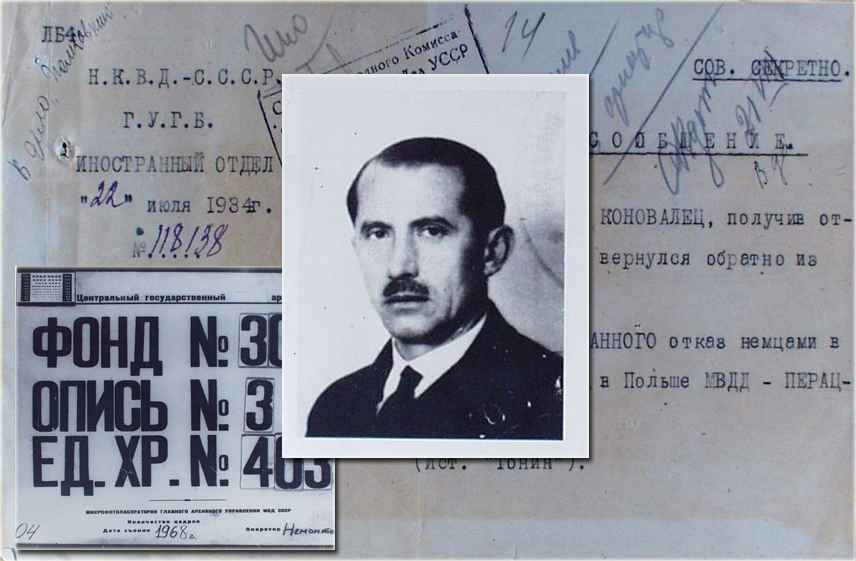
May 23, 1938, Pavlo Sudoplatov, an employee of the NKVD of the USSR, killed the head of the OUN Provid (leadership - transl.), Yevhen Konovalets. The fatal explosion in Rotterdam was the culmination of the Soviet GPU-NKVD’s long-running large-scale operation, which was personally instructed by Joseph Stalin. Even though the circumstances of the operation have been carefully studied and described, documents from the archives of the Foreign Intelligence Service of Ukraine, still unknown to the public, allow to add to the general picture and answer the question discussed by scientists and historians in recent decades: did Ye. Konovalets have a chance in that situation to get rid of the Soviet secret services’ close attention and stay alive?
The operation to neutralize and liquidate Yevhen Konovalets was developed by the central apparatus of the OGPU (later NKVD) of the USSR. It was called “Stavka” (“Stake”- transl). The task was clear: not to track, not to compromise, namely to kill. All the related materials are in Moscow. They reflect the goals, plans, operational measures, performers, etc. Those documents could shed light on hitherto unexplained individual episodes and provide more information to understand what happened then. Much more than P. Sudoplatov mentioned in his memoirs, who left some things unsaid, and presented others in a light favorable to him or the system of that time.
The materials in the Branch State Archive of the SZR of Ukraine are some notes, special messages, intelligence messages, memoranda, mostly copies, dated 1933–1937. That is the period when the operation was conceived and developed. The GPU of the Ukrainian SSR in this situation acted as an auxiliary unit with its operational sources, infiltrated at one time in the environment of Ukrainian emigration. And the future main executor, Pavel Sudoplatov, had already been transferred in the line of duty from Kharkiv to Moscow.
At that time, the task to resolutely fight Ukrainian foreign nationalist centers was one of the main for the Foreign Intelligence of the USSR and its units in the Ukrainian SSR. In 1933, the Head of the OGPU of the USSR, Vyacheslav Menzhinsky, signed an order to develop an action plan to neutralize the OUN and its leaders.
Having received the directives, the Foreign Department of the GPU of the Ukrainian SSR immediately sent its proposals to Moscow. Among other things, there was an idea to infiltrate proven and reliable agents into Yevhen Konovalets' environment, who could learn about the plans of the main leader of the OUN and thus influence the course of events.
In its arsenal, the GPU of the Ukrainian SSR already had an agent Vasyl Lebid. After he had agreed to cooperate, he was soon included by the Chekists in the list of especially valuable agents. Here's how it happened.
During the First World War, V. Lebid served in the units of the Ukrainian Sich Riflemen, where he met Ye. Konovalets. During the national liberation struggle in Ukraine, they fought together against units of the Red Army and other enemies of the UPR. After the Ukrainian Army found itself on the territory of Poland and stopped open resistance, Ye. Konovalets sent loyal comrades to Ukraine to organize underground cells and the insurgent movement. One of those was V. Lebid. But he failed to develop underground work. He immediately fell into the hands of the Ukrainian Chekists and in exchange for his own and his family's life and peace he agreed to cooperate.
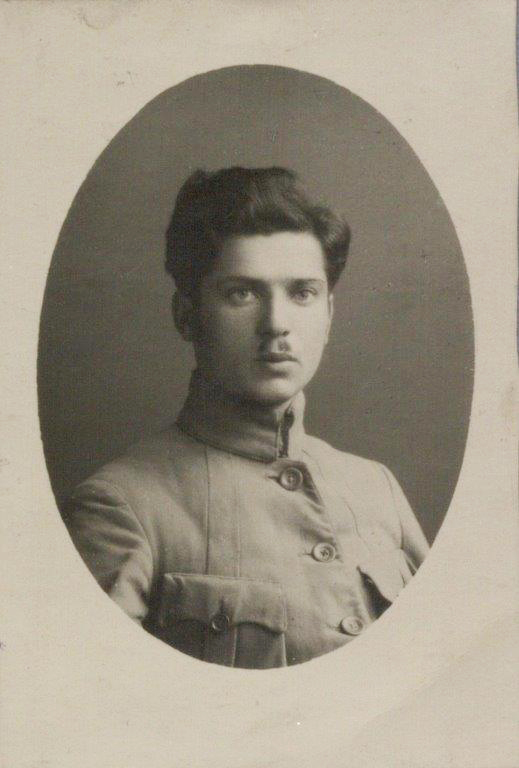 Until now, historians had been describing the circumstances of V. Lebid's getting acquainted with E. Konovalets differently. One of the declassified documents clears the situation. It is a report hand-written in Ukrainian by V. Lebid himself. He pointed out: “I have known Yevhen Konovalets since 1917 from the SS (Sich Riflemen-author), whom he commanded. While in the SS, I was personally acquainted with him. I met him closely through the Chief of Staff of the SS Andriy Melnyk, with whom I had been closely acquainted since 1914 from the USS (Ukrainian Sich Riflemen- author) Regiment of the Austrian army, and I was his company commander ”(BSA of the SZR of Ukraine). - F. 1. – Case 6964. - P. 28).
Until now, historians had been describing the circumstances of V. Lebid's getting acquainted with E. Konovalets differently. One of the declassified documents clears the situation. It is a report hand-written in Ukrainian by V. Lebid himself. He pointed out: “I have known Yevhen Konovalets since 1917 from the SS (Sich Riflemen-author), whom he commanded. While in the SS, I was personally acquainted with him. I met him closely through the Chief of Staff of the SS Andriy Melnyk, with whom I had been closely acquainted since 1914 from the USS (Ukrainian Sich Riflemen- author) Regiment of the Austrian army, and I was his company commander ”(BSA of the SZR of Ukraine). - F. 1. – Case 6964. - P. 28).
Further in the paper, V. Lebid gives relevant arguments, apparently at the request of the GPU operations officers who wanted to know for sure that he really was in a close relationship with Ye. Konovalets, could gain his trust and perform the tasks set. The agent recalls that after the overthrow of the Hetmanate, Ye. Konovalets entrusted him with negotiations with Otaman Zelenyi, who then opposed the Directory. Besides, he notes that he served together with Ye. Konovalets' brother Stepan: “I have know Konovalets Jr. since the time in the Sich Riflemen, where he was under my command as a company commander. I was acquainted with him very closely all the time, and the relations between us were not only those of acquaintances, but of close comrades ”(BSA of the SZR of Ukraine. - F. 1. – Case 6964. - P. 30).
V. Lebid was so meticulously questioned not for nothing. After all, he was to play one of the key roles in the operation and become an important link in finding out the intentions of Ye. Konovalets and collecting intelligence on him.
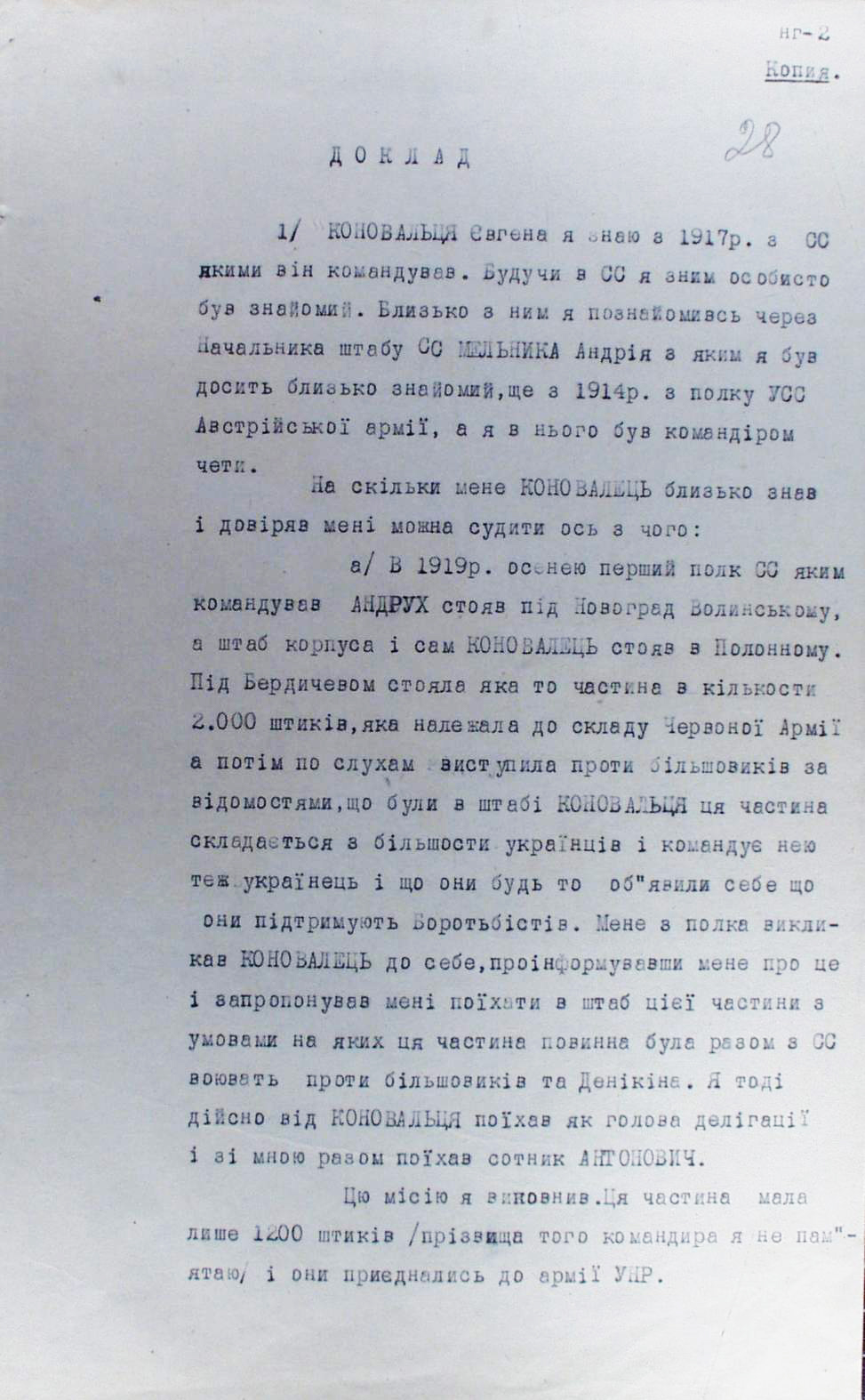
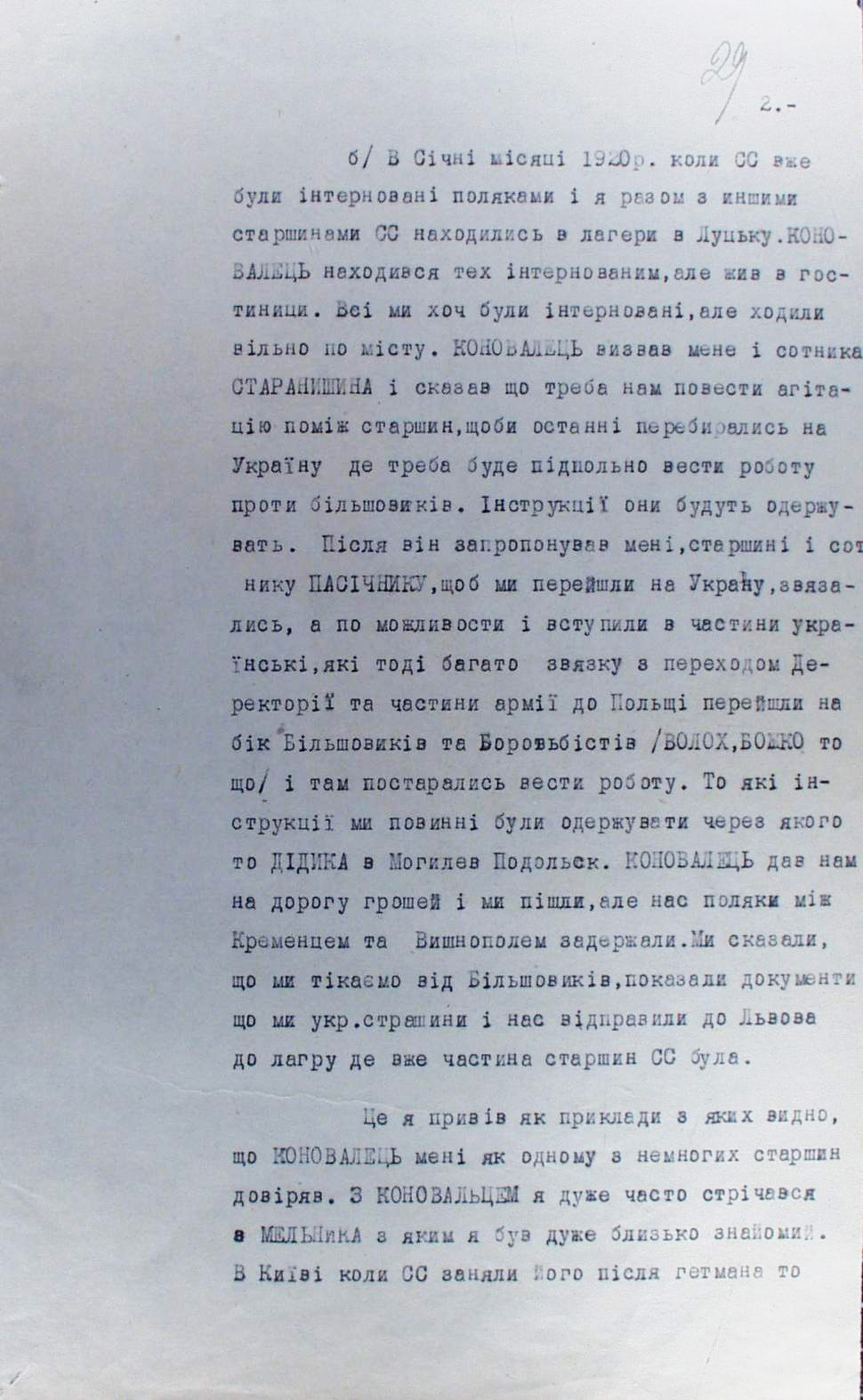
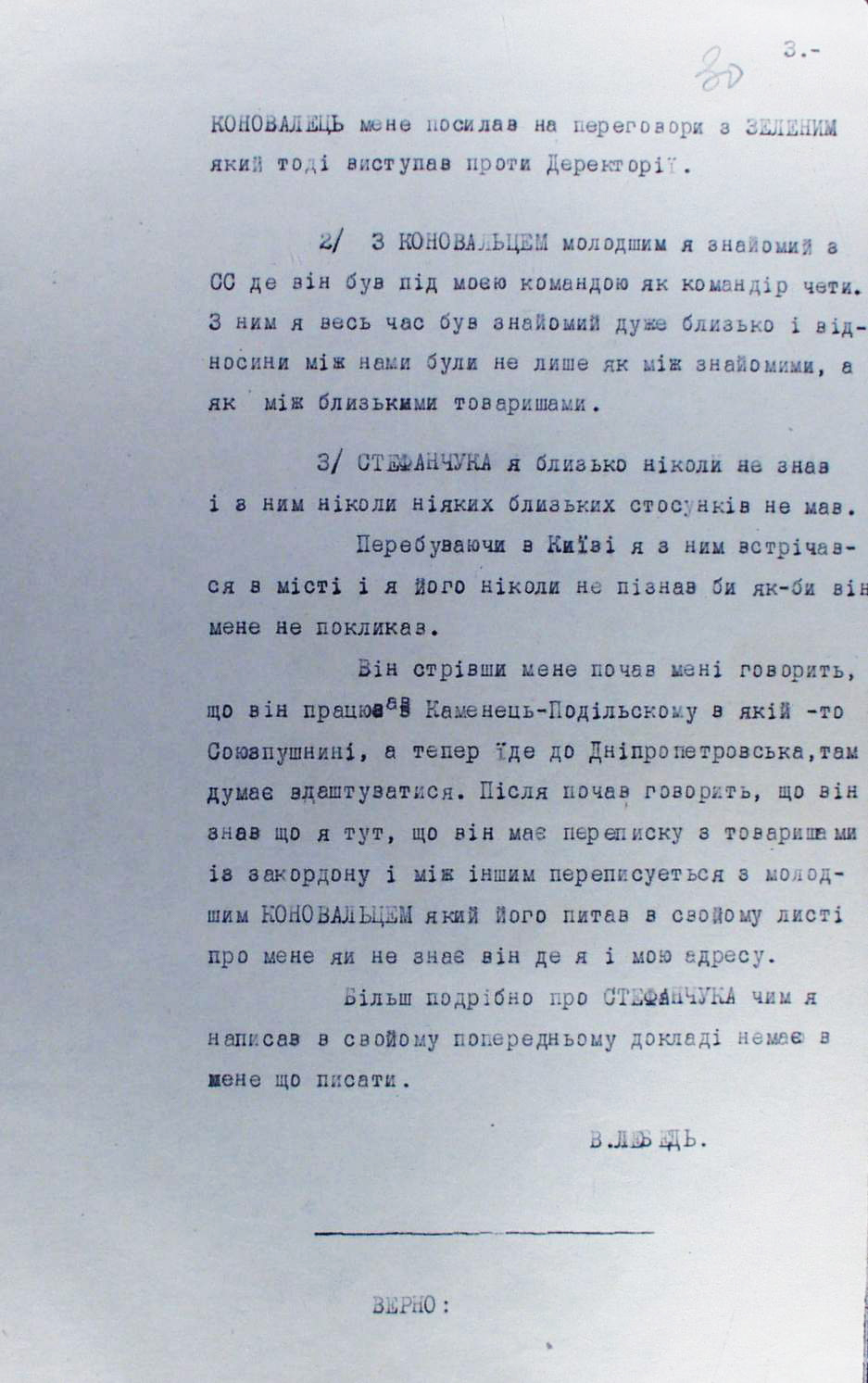 Acting on Chekists’ instructions, V. Lebid arrived in Belgium in August 1933 on a Soviet cargo ship. There he found a member of the OUN leadership, Dmytro Andriyevskyi. Later, Yevhen Konovalets came to Brussels.
Acting on Chekists’ instructions, V. Lebid arrived in Belgium in August 1933 on a Soviet cargo ship. There he found a member of the OUN leadership, Dmytro Andriyevskyi. Later, Yevhen Konovalets came to Brussels.
According to the legend, V. Lebid, who at that time had the surname Khomyak, convincingly told about the underground work he had established in Ukraine, which in fact had not happen. He allegedly worked as a financier in a construction trust in Kharkiv in the early 1930s, and when the arrests began, he disappeared from the city and hid for a while, then, with false documents, with the help of acquaintances got a job on a Soviet ship on which he arrived in Belgium.
Ye. Konovalets insisted that V. Lebid return to Ukraine to build an underground network. Finally, in October 1934, the agent arrived in the USSR and reported to the GPU that he had fulfilled the task of gaining the trust of the OUN leadership.
At the next stage, it was decided to infiltrate in the OUN (with the mediation of Lebid-Khomyak) a career officer of the NKVD Central Office. Pavel Sudoplatov was chosen for the role. He had to pretend to be an idea-driven fighter for Ukraine's independence. In letters to Ye. Konovalets, V. Lebid reported that he had recruited for the underground work a former Komsomol member, his old acquaintance, whom he had educated in a nationalist spirit, and believed that he would be a useful person for the Ukrainian cause. He suggested that the young man should be sent abroad for special training. At the same time, P. Sudoplatov was intensively trained for this trip and taught German for almost a year.
In June 1935, V. Lebid and P. Sudoplatov, who took the name Pavlus Valyukh, arrived in Finland, where shortly before that NKVD officers had legalized another OUN agent, Kindrat Poluvedko.
Having stayed at K. Poluvedko’s for a few months, P. Sudoplatov soon managed to meet with E. Konovalets and establish a trusting relationship with him. Vasyl Lebid presented him as his nephew, a representative of the new generation of Ukrainian youth who were disappointed in the Soviet reality and ready to fight for the restoration of Ukraine's independence. Gradually, relations between Sudoplatov and the Head of the OUN leadership became friendly. Together, they traveled to Paris and Vienna, where they met with Ukrainian emigration leaders to discuss plans for a possible nationalist underground in Ukraine in the event of war.
All the time, until P. Sudoplatov left for abroad and after his return to the USSR, Ye. Konovalets, according to archival documents, was closely monitored. Soviet intelligence stations in Germany, Switzerland, France, Belgium, the Netherlands, Lithuania, and other countries were involved. The scale of this surveillance, the number of agents involved, the use of various operational forms and methods, and the awareness of the movement of the surveillance object are impressive.
Here is an excerpt from the report of a resident of the OGPU in Paris dated December 12, 1933 on the arrival of V. Lebid and his meetings with leading figures of Ukrainian emigrants: “The second meeting was at Andriyevsky's apartment with Stsiborskyi, who came from Paris and was asking him questions for a long time. Then Bohush arrived from Geneva. Everyone was especially interested in the situation in Ukraine. Finally, Andriyevskyi came to Lebid and invited him to his home. Having arrived, he saw an acquaintance sitting in a chair. It was Konovalets, who came from Berlin. The latter asked him to tell in detail where he had been and what he had been doing since he had sent him on a business trip. The story took 4 hours to be told. “Lebid” got an impression that Konovalets was not distrustful of him in any case”. (BSA of the SZR of Ukraine. - F. 1. - Case 6964. - P. 6).
Many documents provide information on Ye. Konovalets’ getting around in Europe and his meetings, such as:
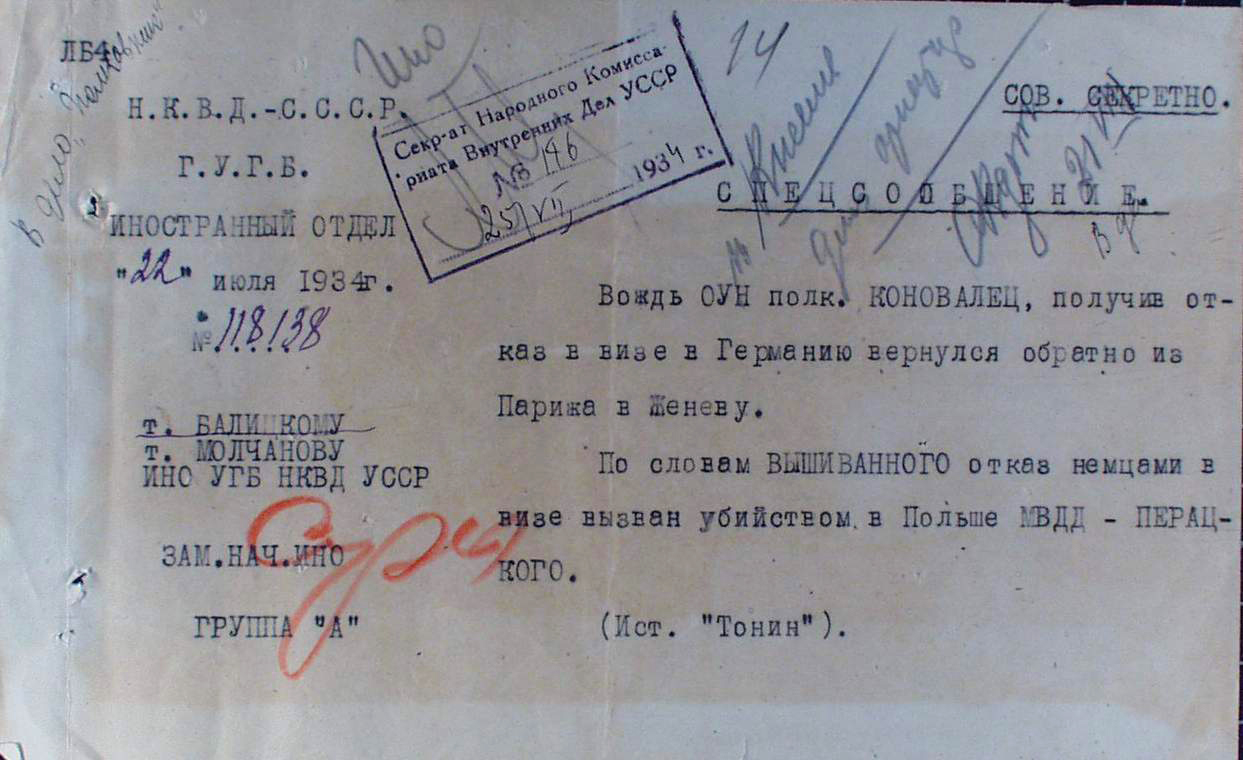
“On April 24, a member of the OUN leadership, Roman Sushko (Chief of the OUN Intelligence), arrived in Berlin. Simultaneously, the leader of the OUN Yevhen Konovalets himself arrived there”. (May 1935).
“Konovalets left Geneva and is temporarily staying in Vienna. He has a residence permit in Austria until April 1, this year”. (March 14, 1936)
“On March 2, Konovalets applied to the Lithuanian government for a permission to enter Lithuania, and the government is currently discussing this issue” (March 14, 1936)
“Colonel Konovalets has received permission to enter America, for which he is going to leave in the second half of April this year. At the moment Colonel Konovalets is in Vienna” (April 26, 1936)
“Colonel Konovalets was in Vienna until May 19. Now he has left for Switzerland and then will go to Paris” (May 23, 1936).
“Colonel Konovalets arrived in Paris in the early summer of this year. He stayed here for a few days and went to America. During his stay in Paris, he lived in Udovychenko’s apartment. There he had a secret meeting with Ukrainian military figures” (July 5, 1936)
«According to the data available, Colonel Yevhen Konovalets is now in Amsterdam and is going to go again to Switzerland, where he is allowed to stay, except for Geneva” (14.10.1936).
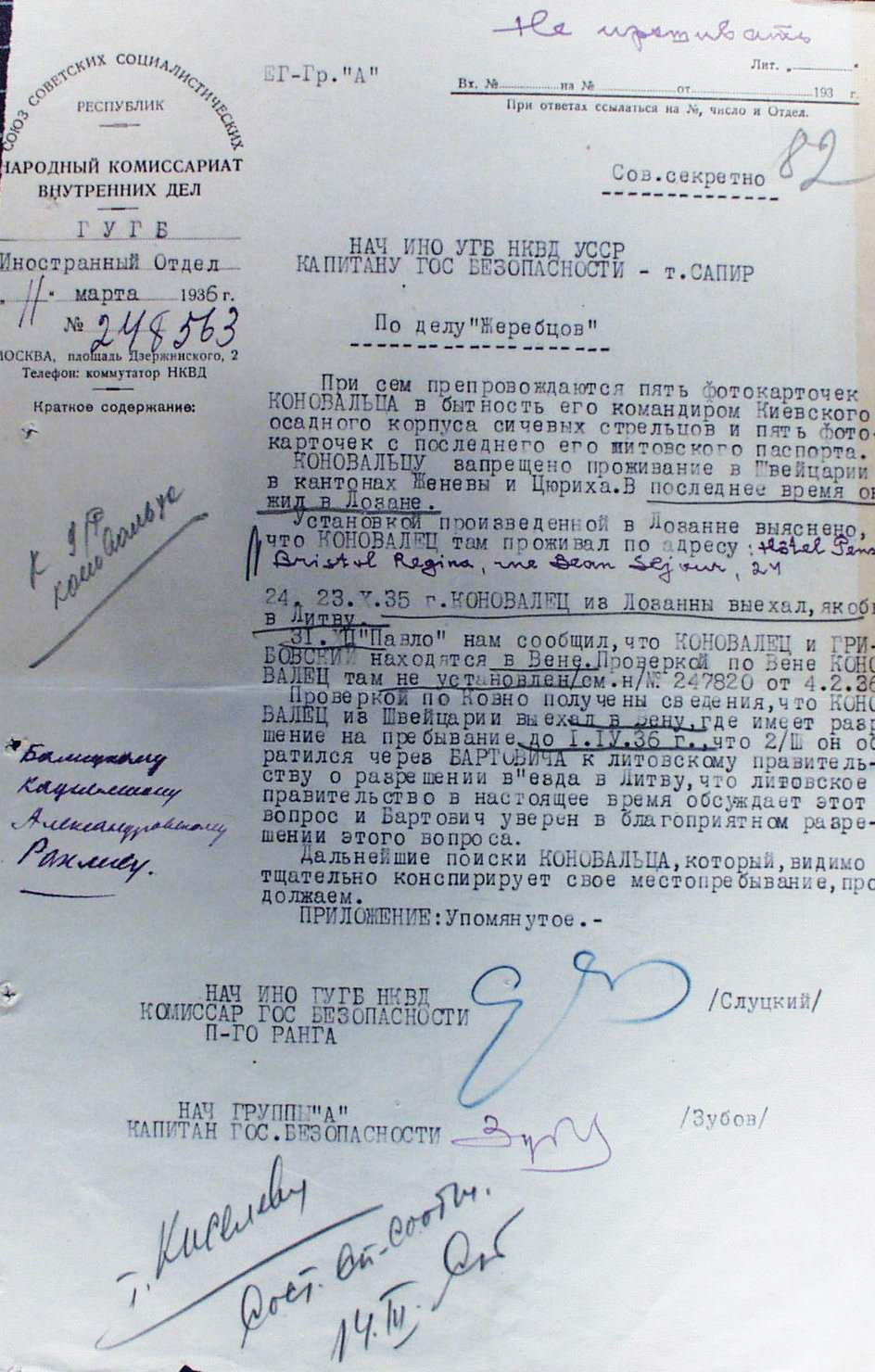
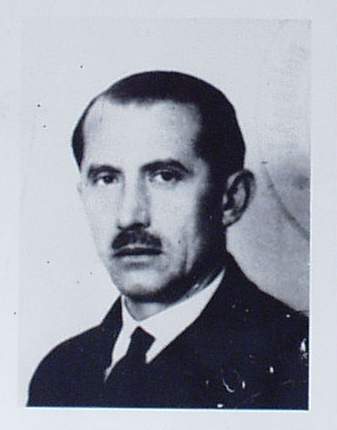
This is evidenced by the document dated August 23, 1937 signed by the Chief of the Foreign Department of the NKVD of the USSR Abram Slutsky and then leader of Group “A” of the same Department Pavel Sudoplatov, which states that the Soviet intelligence agents in Paris managed to read a letter from Yevhen Konovalets to General Mykola Kapustyanskyi, one of the OUN activists. According to the station, NKVD agents in M. Kapustyanskyi's close circle learned that he had been urgently summoned to Vienna for a secret meeting at which the fate of Ukraine was supposed to be determined. He shared this information with seemingly devoted fellowmen, and at this, he more than once took out of his pocket a letter from Ye. Konovalets and reread it.
To find out what else was written in the letter, the agents resorted to certain tricks. They persuaded the General to take a bath before leaving, and at that time they took the letter and copied it by hand. In this way, Moscow learned about Ye. Konovalets’ plans and the routes of his trips. And under such circumstances, it was objectively impossible to avoid close monitoring from the Soviet secret services, while he could not afford to hide, hunker down, and lie deep underground. After all, he cared not so much about his own security as about the interests of the Ukrainian cause.
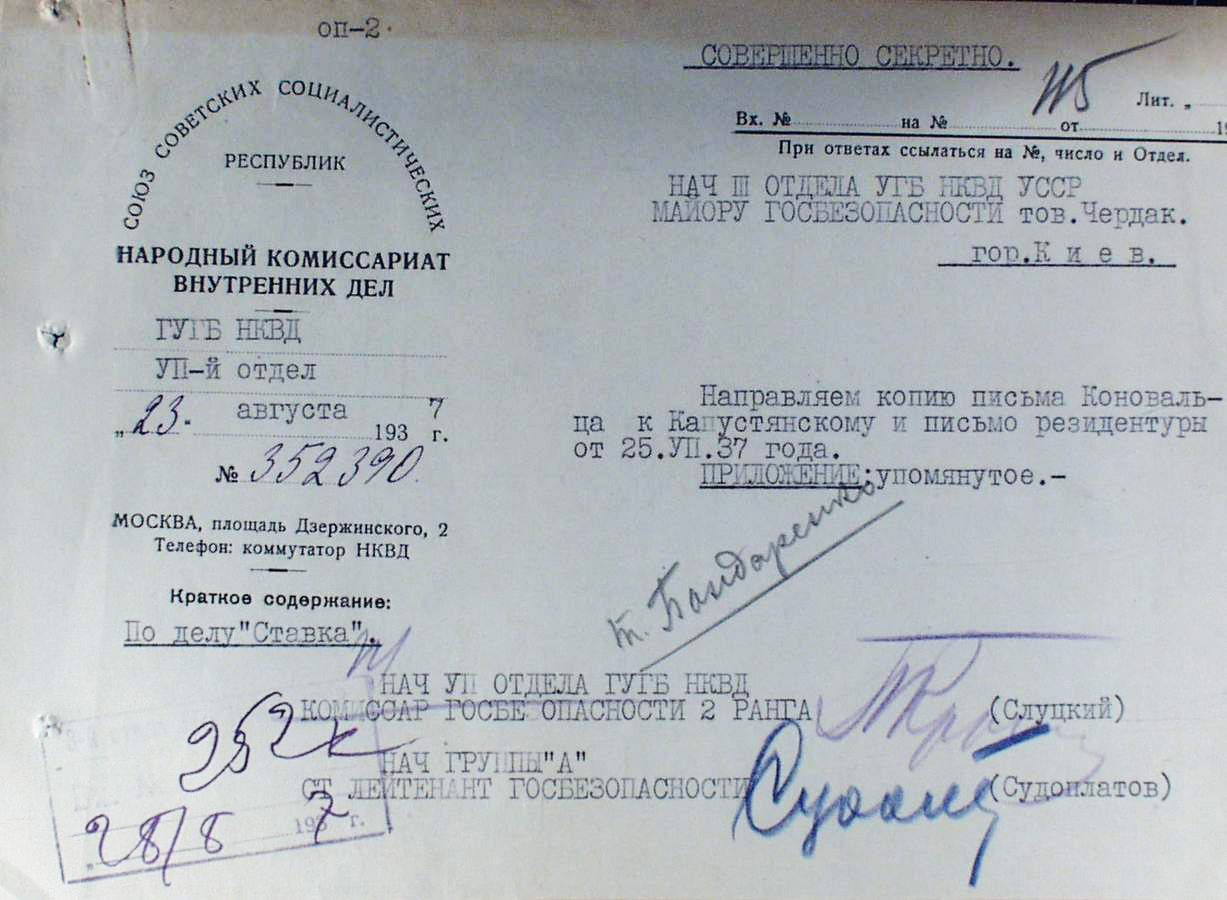
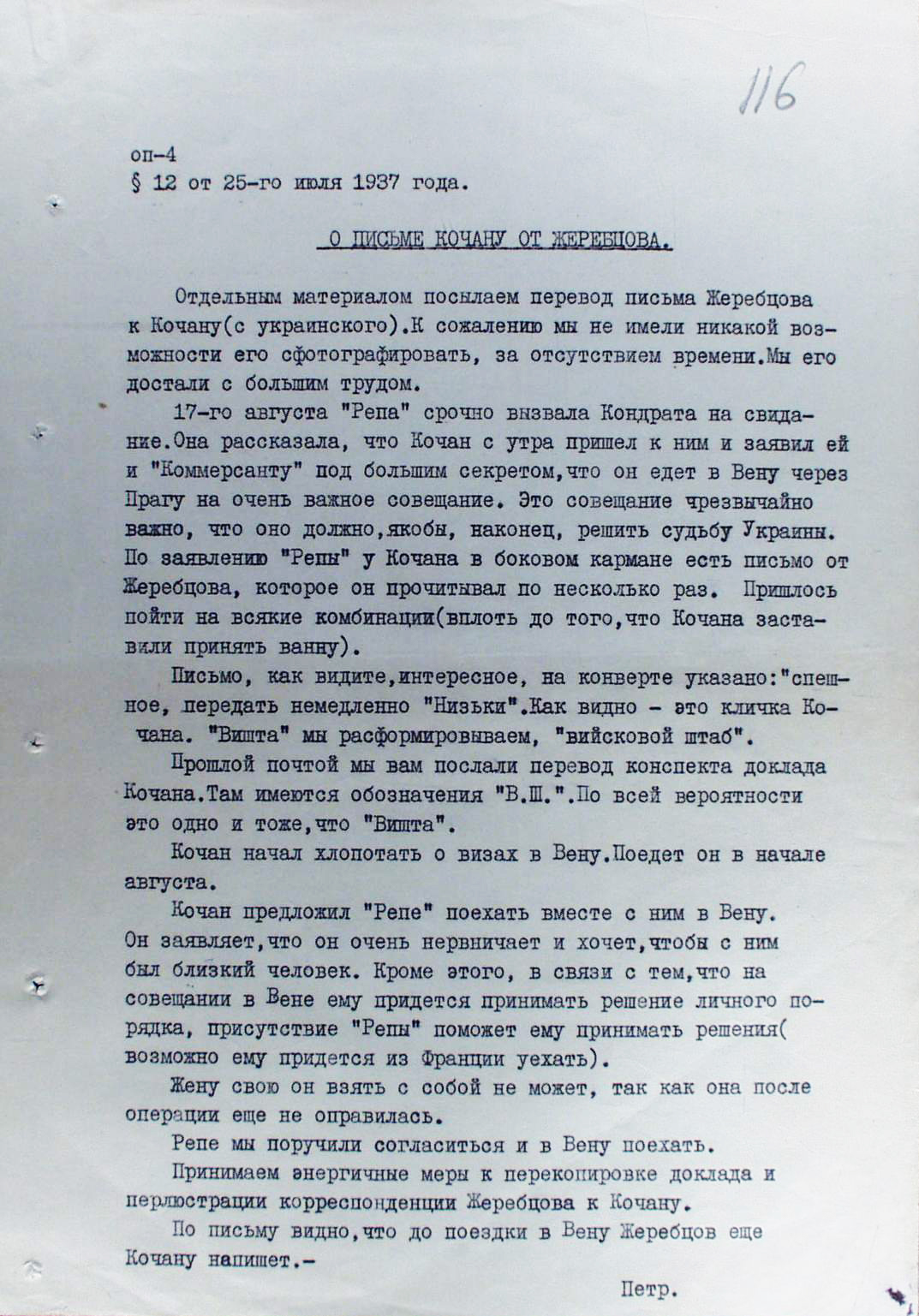
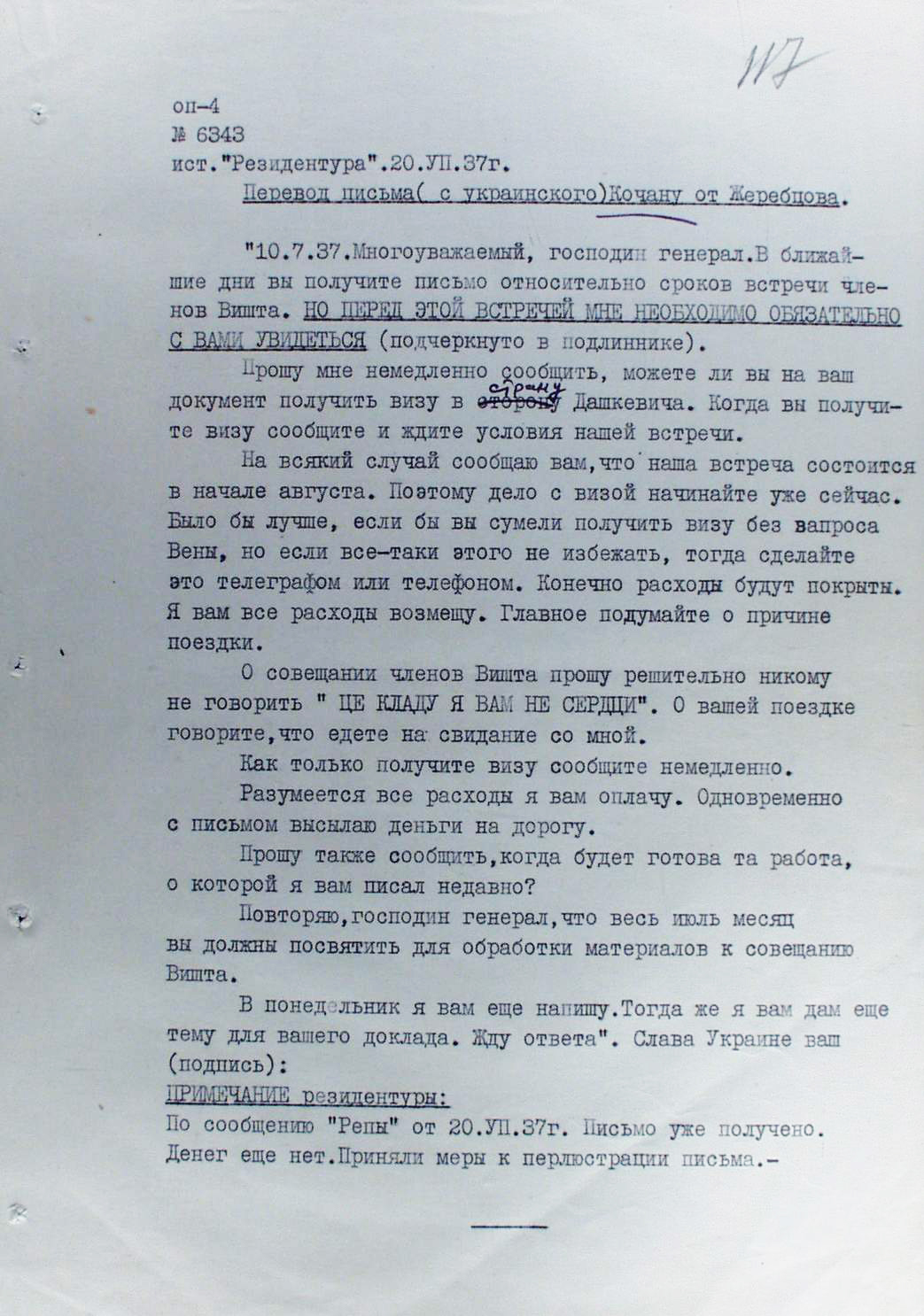 Of course, the NKVD of the USSR, despite the total nature of surveillance, could not cover everything. Because Ye. Konovalets realized that the powerful machine of Soviet special services was working against him. He did resort to certain measures of conspiracy. This is evidenced by archival documents, including a paper entitled “OUN’s Activity” dated November 20, 1936. It is a photocopy from the Central State Archive of the Ministry of Internal Affairs of the USSR (Leningrad), which reads the following regarding the operational checking on Ye. Konovalets: “Such checking was not usually easy due to the strong secrecy in the work of the OUN and the fact that often even experienced professionals in some countries are not aware of the main lines of work of Konovalets and Small Provid (minor leadership- transl.)”(BSA of the SZR of Ukraine. - F. 1. – Case 6964. – P. 150-06).
Of course, the NKVD of the USSR, despite the total nature of surveillance, could not cover everything. Because Ye. Konovalets realized that the powerful machine of Soviet special services was working against him. He did resort to certain measures of conspiracy. This is evidenced by archival documents, including a paper entitled “OUN’s Activity” dated November 20, 1936. It is a photocopy from the Central State Archive of the Ministry of Internal Affairs of the USSR (Leningrad), which reads the following regarding the operational checking on Ye. Konovalets: “Such checking was not usually easy due to the strong secrecy in the work of the OUN and the fact that often even experienced professionals in some countries are not aware of the main lines of work of Konovalets and Small Provid (minor leadership- transl.)”(BSA of the SZR of Ukraine. - F. 1. – Case 6964. – P. 150-06).
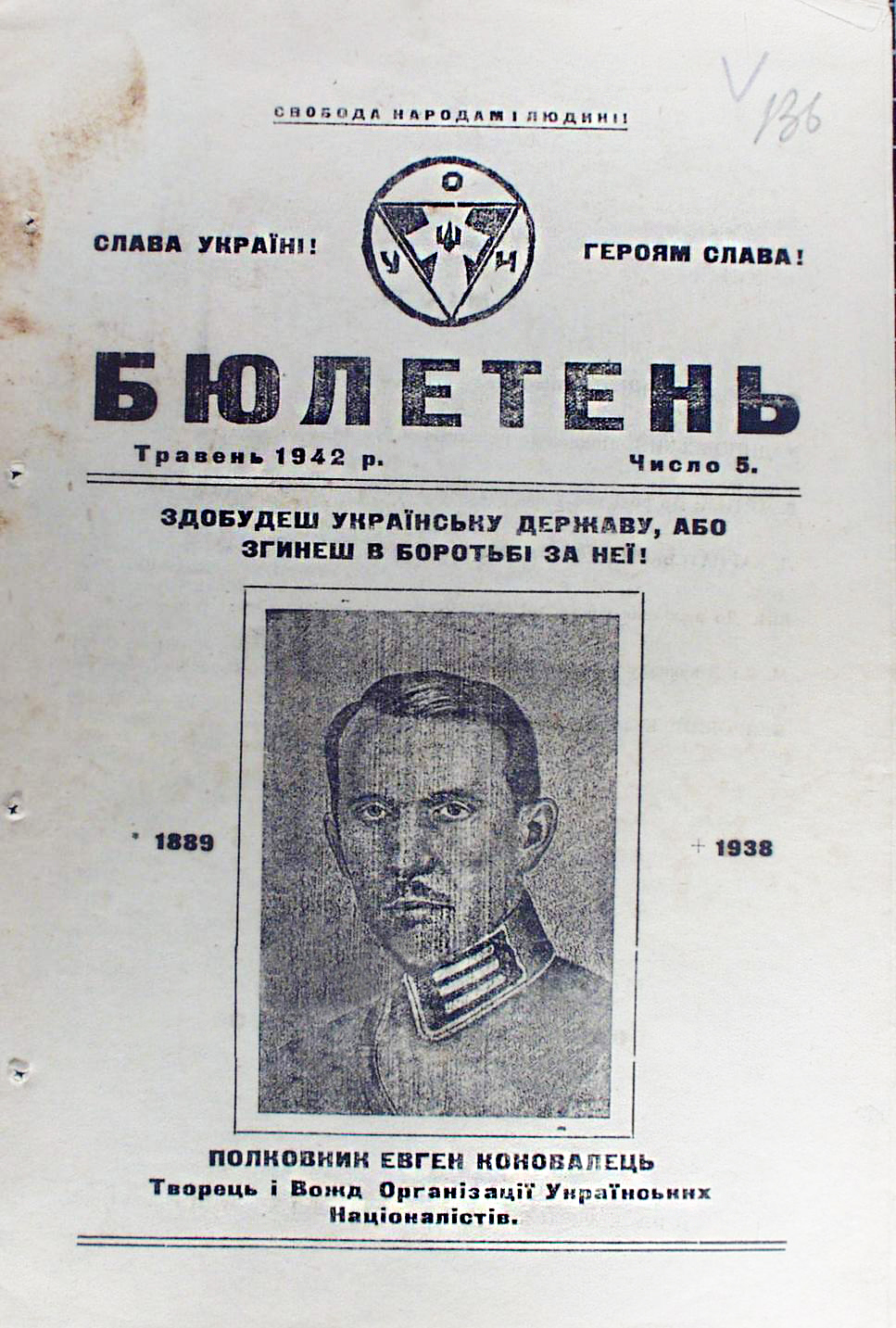 This and a number of other documents concerning the activities of the OUN and its leader Yevhen Konovalets were sent from the Leningrad archives to Kyiv in 1968 on instructions from Moscow. There is a handwritten note in the case, which states: “In 1968, OUN organizations were going to mark in Rotterdam the 30th anniversary of the death of Ye. Konovalets. In response to the Center's instructions, we were preparing measures to discredit the actions of the OUN members. For this purpose, we requested photocopies of the documents on Konovalets' anti-Soviet activities available from the Central State Archive (Leningrad). These documents were used in articles published to discredit Konovalets in the newspaper “Visti z Ukrainy”(“News from Ukraine”- transl.) (BSA of the SZR of Ukraine. - F. 1. - Case 6964. - P. 149).
This and a number of other documents concerning the activities of the OUN and its leader Yevhen Konovalets were sent from the Leningrad archives to Kyiv in 1968 on instructions from Moscow. There is a handwritten note in the case, which states: “In 1968, OUN organizations were going to mark in Rotterdam the 30th anniversary of the death of Ye. Konovalets. In response to the Center's instructions, we were preparing measures to discredit the actions of the OUN members. For this purpose, we requested photocopies of the documents on Konovalets' anti-Soviet activities available from the Central State Archive (Leningrad). These documents were used in articles published to discredit Konovalets in the newspaper “Visti z Ukrainy”(“News from Ukraine”- transl.) (BSA of the SZR of Ukraine. - F. 1. - Case 6964. - P. 149).
Thus, Soviet propaganda tried to destroy the very memory of Yevgen Konovalets, using archives in Moscow and Leningrad, as well as trophy documents obtained after the World War II. At the same time, recent history has already placed emphases on information that has been collected and accumulated in the archives of the GPU-NKVD-KGB for decades and given them an appropriate assessment and interpretation from today's positions and in terms of the motives for the actions of leading figures of the Ukrainian national liberation movement, who at all times fought for freedom and independence of Ukraine.
But the memory of Ye. Konovalets lives in the names of streets named after him in Kyiv, Lviv, Ivano-Frankivsk, Ternopil, Lutsk, Rivne, Zhytomyr, Dnipro, Poltava and many other towns and villages, in the names of schools, in monuments, memorial plaques, numerous books and documentaries. And on the grave of Ye. Konovalets in Rotterdam in the Crooswijk General Cemetery on the day of his death on May 23 and on his birthday on June 14, there are solemn commemorations with the participation of Ukrainian diplomats, military and representatives of the Ukrainian emigrants.
